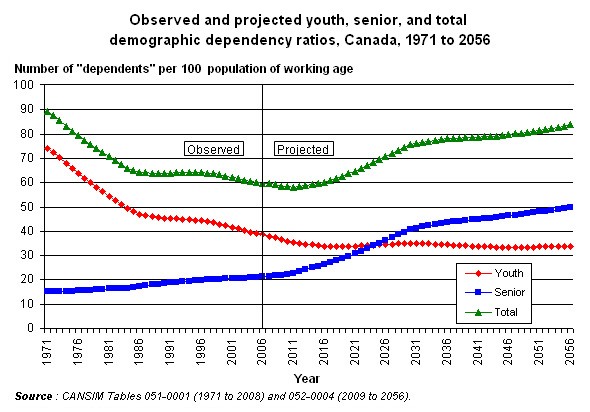Publications
Healthy people, healthy places
+Demographic change
+Health status
+Health behaviours
+Environment
Dependency ratio
Archived Content
Information identified as archived is provided for reference, research or recordkeeping purposes. It is not subject to the Government of Canada Web Standards and has not been altered or updated since it was archived. Please "contact us" to request a format other than those available.
The total demographic dependency ratio is the ratio of the combined youth population (0 to 19 years) and senior population (65 or older) to the working-age population (20 to 64 years). It is expressed as the number of "dependents" for every 100 "workers":
youth (ages 0 to 19) + seniors (age 65 or older) per 100 workers (aged 20 to 64).
The youth demographic dependency ratio is the ratio of the youth population to the working-age population; the senior demographic dependency ratio is the ratio of seniors to the working-age population.
The demographic dependency ratio is based on age rather than employment status. It does not account for young people or seniors who are working, nor for working-age people who are unemployed or not in the labour force. It merely reflects population age structure and is not meant to diminish the contributions made by people classified as "dependents."
Importance of indicator
A sizeable share of seniors aged 65 or older and children and youth younger than age 20 are likely to be socially and/or economically dependent on working-age Canadians, and they may put additional demands on health services. The demographic dependency ratio measures the size of the "dependent" population in relation to the "working age" population who theoretically provide social and economic support.
Changes in demographic dependency ratios highlight changes in the age composition of the population.
Background
The shrinking percentage of young people means that in the future, the number of workers may be insufficient to finance the pensions of retirees1.
The increasing senior population relative to working-age people has implications for the care of seniors. Moreover, substantial numbers of women, who historically have been the primary caregivers of children and seniors, have entered the labour force in recent decades. In addition, because many couples have children at older ages, a generation has emerged that is responsible for young children and elderly parents at the same time—the "sandwich generation"2.
Highlights and graph
Time trend

- Between 1971 and 2006, the total demographic dependency ratio fell from 89 to 60 dependents per 100 workers.
- Stability of the total demographic dependency ratio throughout the 1980s and 1990s was attributable to a decreasing youth demographic dependency ratio that was offset by an increasing senior demographic dependency ratio.
- Canada's total demographic dependency ratio is projected to rise to 84 dependents for every 100 people of working age by 2056, as the proportion of seniors increases.
- In 1971, the youth demographic dependency ratio was 74 youth for every 100 working-age people. This dropped to 39 youth in 2006 and is projected to drop further to 34 youth for every 100 working-age people by 2056.
-
The opposite trend is evident for seniors. For every 100 working-age people, there were 15 seniors in 1971 and 21 in 2006. By 2056, it is projected that there will be 50 seniors for every 100 workers.
- The decreasing youth demographic dependency ratio and the increasing senior demographic dependency ratio show that more people are moving out of the working age range than into it.
References
1. Chawla RK. Dependency ratios: an international comparison. Perspectives on Labour and Income (Statistics Canada, Catalogue 75-001) 1990; Summer 2(2):50-57.
2. Williams C. The sandwich generation. Canadian Social Trends (Statistics Canada Catalogue, 11-008) Summer 2005:16-21.
Other studies
Burke, MA. An aging society, Another viewpoint: Dependency ratios. Canadian Social Trends (Statistics Canada, Catalogue 11-008) 1991; Spring (20): 3-5.
- Date modified:
